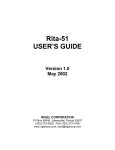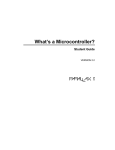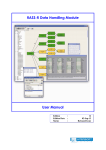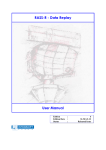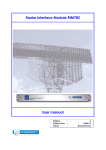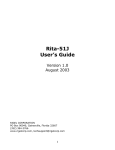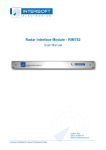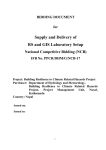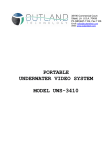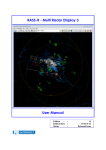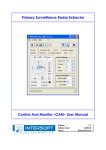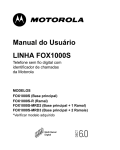Download rass-r ie
Transcript
IE-Proxy User Manual Edition Edition Date Status : : : 4 03/06/13 Released DOCUMENT IDENTIFICATION SHEET DOCUMENT DESCRIPTION Document Title IE-Proxy User Manual 4 EDITION : Document Reference Number EDITION DATE : 03/06/13 Abstract The IE-Proxy is an Intersoft tool acting as bridge for Inter Application Communication within the different RASS-R software modules. More important, the IE-Proxy is also a SNMPv1 gateway to connect a scalable RASS-R system with a 3rd party SNMP-manager. In ATC Centres where RASS-R is installed as ‘Recording and Replay’-system, MIB-II and Intersoft’s private MIB messages are exchanged with the ATC Centre SNMP-Manager. Inter Application Communiation IAC SNMP agent CONTACT PERSON : Keywords MIB-II SNMPv1 SNMP manager BERT SAUVILLER Intersoft Private MIB Network Management Station RASS-R TEL : +32 14 231811 DOCUMENT STATUS AND TYPE STATUS Working Draft Draft Proposed Issue Released Issue CATEGORY Executive Task Specialist Task Lower Layer Task ELECTRONIC BACKUP IE-UM-00026-004 IE-PROXY.doc INTERNAL REFERENCE NAME : HOST SYSTEM MEDIA SOFTWARE(S) Windows XP Pro Type : Hard disk Word 2003 Media Identification : IE-Proxy User Manual -3- DOCUMENT APPROVAL The following table identifies all authorities who have successively approved the present issue of this document. AUTHORITY NAME AND SIGNATURE DATE Author Bert Sauviller 30/10/08 Editors Dirk De Bal Jeroen Janssens Glenn Bosmans 04/11/08 11/05/09 03/06/13 Director ATC Director Software Department Ing. M. Vanuytven Ir. E. Moons COPYRIGHT The IE-Proxy Software have been developed and copyrighted by Intersoft Electronics and are licensed to you on a non-transferable basis. Under the copyright laws, this manual and/or the software may not be copied, in whole or part, except to make a backup copy of the software. © Copyright 1992-2009 Intersoft Electronics. All rights reserved. TECHNICAL SUPPORT Should you have any problems with this document, and/or do not readily find an answer in the present document or need further assistance please contact us using the following contact address: Intersoft Electronics NV Lammerdries, 27 B-2250 Olen BELGIUM Telephone : (+32)14.23.18.11 FAX : (+32)14.23.19.44 We appreciate your feedback and welcome your comments about the tool and this document. You may want to send your comments and remarks to the following e-mail address: [email protected] IE-Proxy User Manual -4- DOCUMENT CHANGE RECORD The following table records the complete history of the successive editions of the present document. EDITION DATE REASON FOR CHANGE 1 05/11/08 2 16/04/09 3 11/05/09 4 03/06/13 New document compatible with software release IE-Proxy v1.0.1 (available from RASS-R v.3.4.0) And with IE REG.MIB revision 0809040000Z IE PROXY.MIB revision 0809040000Z IE DHM.MIB revision 0809040000Z New document compatible with software release IE-Proxy v1.2.0 (available from RASS-R v.3.5.0) User manual compatible with v1.2.1 and IE REG.MIB revision 0905060000Z IE PROXY.MIB revision 0905060000Z IE DHM.MIB revision 0905060000Z User manual compatible with v1.2.2 and IE REG.MIB revision 0905060000Z IE PROXY.MIB revision 0905060000Z IE DHM.MIB revision 0905060000Z Logo updated SECTIONS PAGES AFFECTED All All All None IE-Proxy User Manual -5- TABLE OF CONTENTS 1. INTRODUCTION ....................................................................................................................................... 7 2. IE-PROXY AS SNMP-AGENT ................................................................................................................. 8 2.1 INSTALLATION OF THE IE-PROXY ............................................................................................................. 8 2.2 SUPPORT OF SNMPV1 MIB-II .................................................................................................................. 9 2.3 SUPPORT OF INTERSOFT PRIVATE MIB .................................................................................................... 10 2.3.1 General MIB file (IE REG.MIB) ................................................................................................... 11 2.3.1.1 2.3.1.2 2.3.2 Data Handler Manager MIB file (IE DHM.MIB) ......................................................................... 13 2.3.2.1 2.3.2.2 2.3.2.3 2.3.3 Structure ................................................................................................................................................... 11 File content............................................................................................................................................... 12 Structure ................................................................................................................................................... 13 Information about the DHM ..................................................................................................................... 14 File content............................................................................................................................................... 18 IE-Proxy MIB file (IE PROXY.MIB) ............................................................................................. 24 2.3.3.1 2.3.3.2 Structure ................................................................................................................................................... 24 File content............................................................................................................................................... 25 3. CASE STUDY 1 ........................................................................................................................................ 27 4. REFERENCES .......................................................................................................................................... 29 TABLE OF FIGURES Figure 1-1: Basic SNMP controlled network ......................................................................................................... 7 Figure 2-1: IE-Proxy installation path ................................................................................................................... 8 Figure 2-2: IE-Proxy service .................................................................................................................................. 8 Figure 2-3: IE-Proxy.exe in Windows Task Manager ............................................................................................ 8 Figure 2-4: IE-Proxy.ini-file .................................................................................................................................. 9 Figure 2-5: Intersoft private MIB files ................................................................................................................. 10 Figure 2-6: MIB tree view IE REG.MIB ............................................................................................................... 11 Figure 2-7: MIB tree view IE DHM.MIB ............................................................................................................. 13 Figure 2-8: MIB tree view IE PROXY.MIB .......................................................................................................... 24 Figure 3-1: Case study 1 configuration ................................................................................................................ 27 Figure 3-2: SNMP-manager HMI ........................................................................................................................ 28 TABLE OF TABLES Table 1: IE DHM.MIB .......................................................................................................................................... 14 IE-Proxy User Manual -6- CONVENTIONS USED IN THIS MANUAL The following conventions are used in this manual: Note: This icon to the left of bold italicized text denotes a note, which alerts you to important information. Caution: This icon to the left of bold italicized text denotes a caution, which alerts you to the possibility of data loss or a system crash. Warning: This icon to the left of bold italicized text denotes a warning, which alerts you to the possibility of damage to you or your equipment. IE-Proxy User Manual -7- 1. Introduction The IE-Proxy is a RASS-R software that performs 2 major tasks: Inter Application Communication (IAC) bridge: it acts as a bridge for the IAC between the different RASS-R modules. For example when the DHM sends (.D6) data by means of a RadarOutput module to the MRD3, this communication is established and maintained by means of IAC with the IE-Proxy working as gateway or bridge. This IAC runs on the background of the computer. You even do not need to be aware of its functioning. Suppose that the IE-Proxy is not running, IAC will fall back on the classic RPC method (Remote Procedure Call). SNMP-agent: the IE-Proxy also acts as SNMP-agent. It receives and sends SNMP messages. To let it work as SNMP-agent, you need to license the IE-Proxy! Otherwise a message of ‘demonstration only’ will appear in the tray manager (The Tray Manager is a RASS-R software tool that appears as icon in the Windows systray). For registration of the IE-Proxy, the IE-Proxy_licence_request.txt file need to be compiled in a registry file by Intersoft. (Refer to the RASS-R Installation manual: IE_RASS-R_InstallationManualvxx.pdf) The figure below represents a standard configuration: multiple RASS-R servers are connected over LAN with multiple RASS-R computers. Typically, a RASS-R server will run the RASS-R DHM server software, while the RASS-R computers run other RASS-R software tools like the DHM Configuration Manager, the Multi Radar Display MRD3, TRACKAN etc. All computers also run the same software module, which is the IE-Proxy. This SNMP-agent makes it possible to exchange SNMP-Messages with a (3rd party) Network Management System. Figure 1-1: Basic SNMP controlled network In the next chapters, it will be explained how the IE-Proxy works as SNMP-agent and which implementation need to be done on any 3rd party SNMP-management system. IE-Proxy User Manual -8- 2. IE-Proxy as SNMP-agent 2.1 Installation of the IE-Proxy The IE-Proxy can be installed by using the RASS-R installer DVD. Refer to the RASS-R installer manual that can be found on the installer DVD. (IE_RASS-R_InstallationManualvxx.doc) Upon completion of the installation, the IE-Proxy is installed in the following path: Figure 2-1: IE-Proxy installation path The IE-Proxy is installed as a Windows service, so no user interface is available. The start-up type is set to “automatic”: Figure 2-2: IE-Proxy service It will be visible in Windows Task Manager as “IE-Proxy.exe”. Figure 2-3: IE-Proxy.exe in Windows Task Manager IE-Proxy User Manual 2.2 -9- Support of SNMPv1 MIB-II The IE-Proxy supports SNMPv1 MIB-II according specification RFC1213. See on http://tools.ietf.org/html/rfc1213#section-3.10 for specifications. From this MIB-II, it supports 2 groups: System Group SNMP Group Information for the System Group can be filled in the IE-Proxy.ini file. C:\Program Files\Intersoft Electronics\RASS\IE-Proxy\IE-Proxy.ini Figure 2-4: IE-Proxy.ini-file The following items can be changed: Port: this is the port number where the IE-Proxy listens on for SNMP-messages. If the SNMP-Manager is sending messages on another port number, you have to change this here. EnableAuthenTraps (True/False): enable or disable the Trap-PDU used in the SNMP Group Community= Change here the community name used in the SNMP-messages Location= string that will be used in the System Group Name= string that will be used in the System Group IE-Proxy User Manual 2.3 - 10 - Support of Intersoft private MIB The IE-Proxy supports the Intersoft private MIB, that consists of 3 subfiles: Figure 2-5: Intersoft private MIB files IE REG.MIB: General MIB-file; this file describes the hierarchical structure for the Intersoft private MIB. IE DHM.MIB: Data Handler Manager MIB-file; this file describes the MIB for the RASS-R Data Handler Module (DHM) IE PROXY.MIB: IE-Proxy MIB-file; this file describes the MIB for the IEProxy. These files needed to be saved in the MIB-list on the Network Management Station (NMS). (The Intersoft private MIB is implemented in the IE-Proxy.exe, so the files need not to be present on the SNMP-agent.) Other MIB files can be added in future releases of the IE-Proxy (for example for the RASS-R MRD3, TRACKAN) Important information: The IE-Proxy does not send any <TRAP_PDU> for the MIB’s above. The IE-Proxy does not support the <SET_REQUEST_PDU> Intersoft has enterprise number 30524. In the next paragraphs, you can read detailed information about all MIB-files. IE-Proxy User Manual 2.3.1 General MIB file (IE REG.MIB) 2.3.1.1 Structure By using a MIB browser, the following structure of the MIB is visible: Figure 2-6: MIB tree view IE REG.MIB - 11 - IE-Proxy User Manual 2.3.1.2 File content IE-REG DEFINITIONS ::= BEGIN IMPORTS MODULE-IDENTITY, OBJECT-IDENTITY, enterprises FROM SNMPv2-SMI; ieRegModule MODULE-IDENTITY LAST-UPDATED "0905060000Z" ORGANIZATION "Intersoft Electronics" CONTACT-INFO "Dirk De Bal email: [email protected]" DESCRIPTION "Revision 1.1 of this module" REVISION "0905060000Z" DESCRIPTION "The Intersoft-Electronics central registration module" ::= {ieModules 1} intersoft-electronics ieReg ieModules OBJECT IDENTIFIER ::={enterprises 30524} OBJECT IDENTIFIER ::= {intersoft-electronics 1} OBJECT IDENTIFIER ::= {ieReg 1} ieGen OBJECT IDENTIFIER ::= {intersoft-electronics 2} ieProds OBJECT IDENTIFIER ::= {intersoft-electronics 3} ieCaps OBJECT IDENTIFIER ::= {intersoft-electronics 4} ieReqs OBJECT IDENTIFIER ::= {intersoft-electronics 5} ieExpr OBJECT IDENTIFIER ::= {intersoft-electronics 6} END - 12 - IE-Proxy User Manual 2.3.2 Data Handler Manager MIB file (IE DHM.MIB) 2.3.2.1 Structure By using a MIB browser, the following structure of the MIB is visible: Figure 2-7: MIB tree view IE DHM.MIB - 13 - IE-Proxy User Manual 2.3.2.2 - 14 - Information about the DHM According to the file structure as pasted in the next paragraph, the following information about the DHM is available: To understand the meaning of all object-types, it is necessary to read the manual about the DHM first! (IE-UM-00025-007 DHM.pdf or higher) Table 1: IE DHM.MIB OBJECT-TYPE DHMMajorVersion DESCRIPTION/values/explanation Description: “The major release number of the DHM SRV software” Values: DHMMinorVersion Explanation: this value can be seen in the DHM Conf. Manager title bar. Description: “The minor release number of the DHM SRV software” DHMBugfixVersion Explanation: this value can be seen in the DHM Conf. Manager title bar. Description: “The bugfix release number of the DHM SRV software" DHMUpTime Explanation: this value can be seen in the DHM Conf. Manager title bar. Description: “The time (in hundredths of a second) since the DHM SRV was last re-initialised” DHMState Explanation: Re-initializing can be done by restarting the DHM server manually (See IE-DHM-UM-v15.pdf paragraph 3.1) or after a restart of the PC where the DHM server runs on. Description: “The current state of the DHM SRV” DHMSessionCount Values: started(1), stopped(2), failed(3) Description: “The current number of sessions managed by DHM SRV" DHMLicense Explanation: Equals the number of sessions visible in the DHM Conf. Manager. Maximum 10 sessions can be loaded. (See IE-DHM-UM-v15.pdf paragraph 4.2.3) Description: “The current license status of the DHM SRV DHMSmgrCount Values: demo(1), registered(2) Description: “The current number of SMGR connected to DHM SRV" DHMMemory Explanation: Multiple DHM Configuration Managers can be connected to the same DHM server. Description: “The current memory occupied by DHM SRV in Kbytes" DHMProcess Explanation: The DHM server is visible as YARDIOS_SRV.exe in Windows Task Manager. (See IE-DHM-UM-v15.pdf figure 4-17) Description: “The current processor load on one CPU core used by the DHM SRV in %". In multiple core computers it is possible this looks strange, because the windows task manager will divide the processor load by the number of cores. It will look like the reported processing load is not correct. Explanation: The DHM server is visible as YARDIOS_SRV.exe in Windows Task Manager. (See IE-DHM-UM-v15.pdf figure 4-17) IE-Proxy User Manual DHMSessionTable DHMSessionIndex DHMSessionName Description: "A unique value for each session" Description: "The name of the session" DHMSessionState Explanation: this is the name of the session as visible in the DHM Configuration Manager. (See IE-DHM-UM-v15.pdf paragraph 4.2.3) Description: The current state of the session" - 15 - Values: running(1), stopped(2), loading(3), error(4) DHMSessionMemory DHMSessionProcess DHMSessionAutoLoad Explanation: See IE-DHM-UM-v15.pdf paragraph 4.2.3, table 3. Description: "The current memory occupation of the session in Kbytes" Explanation: Each session is visible as YARDIOS_SESSION_ENGINE_#.exe in Windows Task Manager (See IE-DHM-UM-v15.pdf figure 4-17) Description: "The current processing load on one CPU core created by the session" In multiple core computers it is possible this looks strange, because the windows task manager will divide the processor load by the number of cores. It will look like the reported processing load is not correct. If you accumulate the load of all sessions it could be higher than100%. Explanation: Each session is visible as YARDIOS_SESSION_ENGINE_#.exe in Windows Task Manager (See IE-DHM-UM-v15.pdf figure 4-17) Description: "The current autoLoad property of the session" Values: no (1), yes (2) DHMSessionAutoRun Explanation: See IE-DHM-UM-v15.pdf paragraph 5.2.7. Description: The current autoRun property of the session" Values: no (1), yes (2) DHMSessionPersistent Explanation: See IE-DHM-UM-v15.pdf paragraph 5.2.7. Description: The current Persistent property of the session" Values: no (1), yes (2) Explanation: See IE-DHM-UM-v15.pdf paragraph 5.2.7. IE-Proxy User Manual - 16 - DHMSessionModulesTable DHMSessionIndex DHMSessionName Description: "A list containing the modules present in a session." Description: “A unique value for each session" Description: “The name of the module" DHMSessionModulesIndex DHMSessionModulesName Explanation: this is the name of the session as visible in the DHM Configuration Manager. (See IE-DHM-UM-v15.pdf paragraph 4.2.3) Description: "A unique value for each module" Description: "The name of the module" DHMSessionModulesState Explanation: the name of modules as described in IE-DHM-UM-v15.pdf Chapter 6. Description: "The current state of the module" Values: stopped(1), running(2), idle(3), error(4) DHMSessionStatusProbe Explanation: See IE-DHM-UM-v15.pdf paragraph 5.2.5 (‘idle’ represents a yellow colored DHM module as in Figure 5-6 of the manual above.) Description: "The time (in hundredths of a second) since the module was last re-initialised" Description: “The current content of the status probe of the module” DHMSessionHardwareTable DHMSessionIndex DHMSessionName Explanation: probes as described in IE-DHM-UM-v15.pdf paragraph 5.2.6. Everytime a DHMSessionStatusProbe is asked, a snapshot of probe data is sent. Description: “A list containing the Hardware present in a session." Description: "A unique value for each session" Description: "The name of the session" DHMSessionHardwareIndex DHMSessionHardwareName Explanation: this is the name of the session as visible in the DHM Configuration Manager. (See IE-DHM-UM-v15.pdf paragraph 4.2.3) Description: "A unique value for each Hardware module" Description: "The name of the Hardware module" DHMSessionHardwareState Explanation: the name of modules as visible in the DHM modules, as described in IE-DHM-UM-v15.pdf Chapter 6. (Example figure 6-160 right: UDR2[81]) Possible hardware devices are: UDR2[xx], TMD[x], ADSBonRIM[x],RVR[xx/xx/xxx], EDR[xx/xx/xxx] with between [x] its serial number. Description: "The current state of the Hardware module" DHMSessionModulesUpTime Values:stopped(1), running(2), idle(3), error(4) DHMSessionHardwareConfig Explanation: See IE-DHM-UM-v15.pdf paragraph 5.2.5 Description: “The current configuration of the Hardware module" Explanation: string with input, output, protocol IE-Proxy DHMSessionNetworkTable User Manual - 17 - DHMSessionIndex DHMSessionName Description: "A list containing the Network modules present in a session." Description: "A unique value for each session" Description: "The name of the session" DHMSessionNetworkIndex DHMSessionNetworkName Explanation: this is the name of the session as visible in the DHM Configuration Manager. (See IE-DHM-UM-v15.pdf paragraph 4.2.3) Description: “A unique value for each Network module" Description: “The name of the Network module" DHMSessionNetworkState Explanation: the name of modules as described in IE-DHM-UM-v15.pdf Chapter 6. Possibilities are: UDPinput, UDPoutput, TCPinput, TCPoutput, PCAP, PCAPoutput Remark that the name is not unique! You should use this in combination with the local and remote IP-address. Description: “The current state of the Network module" Values:Stopped(1), running(2), idle(3), error(4) DHMSessionNetworkLocalIP DHMSessionNetworkRemoteIP DHMSessionNetworkPacket DHMSessionNetworkUpTime DHMSessionNetworkProbe Explanation: See IE-DHM-UM-v15.pdf paragraph 5.2.5 Description: "The current LocalIP configuration of the Network module" Explanation: the local IP address as described in IE-DHM-UM-v15.pdf Chapter 6. Description: "The current RemoteIP configuration of the Network module" Explanation: the remote IP address as described in IE-DHM-UMv15.pdf Chapter 6. Description: "The current number of packets processed since last reset of the Network module" Explanation: Description: "The time (in hundredths of a second) since the network module was last re-initialised" Description: "The current content of the probe of the Network module" Explanation: probes as described in IE-DHM-UM-v15.pdf paragraph 5.2.6. Everytime a DHMSessionNetworkProbe is asked, a snapshot of probe data is sent. IE-Proxy User Manual 2.3.2.3 - 18 - File content IE-DHM DEFINITIONS ::= BEGIN IMPORTS MODULE-IDENTITY, OBJECT-TYPE, TimeTicks, IpAddress FROM SNMPv2-SMI ieProds, ieModules FROM IE-REG; ieDhmModule MODULE-IDENTITY LAST-UPDATED "0905060000Z" ORGANIZATION "Intersoft-Electronics" CONTACT-INFO "Dirk De Bal email: [email protected]" DESCRIPTION "The revision 1.1 of this module" REVISION "0905060000Z" DESCRIPTION "The initial revision of this module" REVISION "0903200945Z" DESCRIPTION "The Intersoft-Electronics DHM MIB" ::={ieModules 2} dhm OBJECT IDENTIFIER ::= {ieProds 1} dhmConfs OBJECT IDENTIFIER ::= {dhm 1} OBJECT IDENTIFIER ::= {dhmConfs 1} OBJECT IDENTIFIER ::= {dhmConfs 2} dhmGroups dhmGompl dhmObjs OBJECT IDENTIFIER ::= {dhm 2} dhmEvents OBJECT IDENTIFIER ::= {dhm 3} dhmMajorVersion OBJECT-TYPE SYNTAX MAX-ACCESS STATUS DESCRIPTION INTEGER read-only current "The major release number of the DHM SRV software" ::= {dhmObjs 1} dhmMinorVersion OBJECT-TYPE SYNTAX MAX-ACCESS STATUS DESCRIPTION INTEGER read-only current "The minor release number of the DHM SRV software" ::= {dhmObjs 2} dhmBugfixVersion OBJECT-TYPE SYNTAX MAX-ACCESS STATUS DESCRIPTION INTEGER read-only current "The bugfix release number of the DHM SRV software" ::= {dhmObjs 3} dhmUpTime OBJECT-TYPE SYNTAX MAX-ACCESS STATUS DESCRIPTION TimeTicks read-only current "The time (in hundredths of a second) since the DHM SRV was last re-initialised" ::= {dhmObjs 4} dhmState OBJECT-TYPE SYNTAX INTEGER { started(1), stopped(2), failed(3) } MAX-ACCESS STATUS DESCRIPTION read-only current "The current state of the dhm SRV" ::= {dhmObjs 5} dhmSessionCount OBJECT-TYPE SYNTAX MAX-ACCESS STATUS DESCRIPTION INTEGER read-only current "The current number of sessions managed by DHM SRV" ::= {dhmObjs 6} dhmLicense OBJECT-TYPE SYNTAX INTEGER { demo(1), registered(2) } MAX-ACCESS STATUS DESCRIPTION read-only current "The current license status of the DHM SRV" ::= {dhmObjs 7} dhmSmgrCount OBJECT-TYPE IE-Proxy User Manual SYNTAX MAX-ACCESS STATUS DESCRIPTION - 19 - INTEGER read-only current "The current number of SMGR connected to DHM SRV" ::= {dhmObjs 8} dhmMemory OBJECT-TYPE SYNTAX MAX-ACCESS STATUS DESCRIPTION INTEGER read-only current "The current memory occupied by dhm SRV in Kbytes" ::= {dhmObjs 9} dhmProcess OBJECT-TYPE SYNTAX MAX-ACCESS STATUS DESCRIPTION INTEGER read-only current "The current processor load used by the DHM SRV in %" ::= {dhmObjs 10} dhmSessionTable OBJECT-TYPE SYNTAX MAX-ACCESS STATUS DESCRIPTION SEQUENCE OF DhmSessionEntry not-accessible current "A list containing information about the current loaded sessions." ::= {dhmObjs 11} dhmSessionEntry OBJECT-TYPE SYNTAX MAX-ACCESS STATUS DESCRIPTION DhmSessionEntry not-accessible current "Entry containing information about the current loaded sessions" INDEX {dhmSessionIndex} ::= {dhmSessionTable 1} DhmSessionEntry ::= SEQUENCE { dhmSessionIndex INTEGER, dhmSessionName OCTET STRING, dhmSessionState INTEGER, dhmSessionMemory INTEGER, dhmSessionProcess INTEGER, dhmSessionAutoLoad INTEGER, dhmSessionAutoRun INTEGER, dhmSessionPersistent INTEGER } dhmSessionIndex OBJECT-TYPE SYNTAX MAX-ACCESS STATUS DESCRIPTION INTEGER (1..2147483647) read-only current "A unique value for each session" ::= {dhmSessionEntry 1} dhmSessionName OBJECT-TYPE SYNTAX MAX-ACCESS STATUS DESCRIPTION OCTET STRING read-only current "The name of the session" ::= {dhmSessionEntry 2} dhmSessionState OBJECT-TYPE SYNTAX INTEGER { running(1), stopped(2), loading(3), error(4) } MAX-ACCESS STATUS DESCRIPTION read-only current "The current state of the session" ::= {dhmSessionEntry 3} dhmSessionMemory OBJECT-TYPE SYNTAX MAX-ACCESS STATUS DESCRIPTION INTEGER read-only current "The current memory occupation of the session in Kbytes" ::= {dhmSessionEntry 4} dhmSessionProcess OBJECT-TYPE SYNTAX INTEGER MAX-ACCESS read-only STATUS current DESCRIPTION IE-Proxy User Manual - 20 - "The current processing load created by the session" ::= {dhmSessionEntry 5} dhmSessionAutoLoad OBJECT-TYPE SYNTAX INTEGER { no(1), yes(2) } MAX-ACCESS STATUS DESCRIPTION read-only current "The current autoload property of the session" ::= {dhmSessionEntry 6} dhmSessionAutoRun OBJECT-TYPE SYNTAX INTEGER { no(1), yes(2) } MAX-ACCESS STATUS DESCRIPTION read-only current "The current autoRun property of the session" ::= {dhmSessionEntry 7} dhmSessionPersistent OBJECT-TYPE SYNTAX INTEGER { no(1), yes(2) } MAX-ACCESS STATUS DESCRIPTION read-only current "The current persistent property of the session" ::= {dhmSessionEntry 8} dhmSessionModulesTable OBJECT-TYPE SYNTAX SEQUENCE OF DhmSessionModulesEntry MAX-ACCESS not-accessible STATUS current DESCRIPTION "A list containing the modules present in a session." ::= {dhmObjs 12} dhmSessionModulesEntry OBJECT-TYPE SYNTAX DhmSessionModulesEntry MAX-ACCESS not-accessible STATUS current DESCRIPTION "Entry in the dhmSessionModulesTable" INDEX {dhmSessionModulesSessionIndex, dhmSessionModulesIndex} ::= {dhmSessionModulesTable 1} DhmSessionModulesEntry ::= SEQUENCE { dhmSessionModulesSessionIndex INTEGER, dhmSessionModulesSessionName OCTET STRING, dhmSessionModulesIndex INTEGER, dhmSessionModulesName OCTET STRING, dhmSessionModulesState INTEGER, dhmSessionModulesUpTime TimeTicks, dhmSessionModulesStatusProbe OCTET STRING } dhmSessionModulesSessionIndex SYNTAX MAX-ACCESS STATUS DESCRIPTION OBJECT-TYPE INTEGER (1..2147483647) read-only current "A unique value for each session" ::= {dhmSessionModulesEntry 1} dhmSessionModulesSessionName OBJECT-TYPE SYNTAX OCTET STRING MAX-ACCESS read-only STATUS current DESCRIPTION "The name of the Session" ::= {dhmSessionModulesEntry 2} dhmSessionModulesIndex OBJECT-TYPE SYNTAX INTEGER (1..2147483647) MAX-ACCESS read-only STATUS current DESCRIPTION "A unique value for each module" ::= {dhmSessionModulesEntry 3} dhmSessionModulesName OBJECT-TYPE SYNTAX OCTET STRING MAX-ACCESS read-only STATUS current DESCRIPTION "The name of the module" ::= {dhmSessionModulesEntry 4} IE-Proxy User Manual dhmSessionModulesState OBJECT-TYPE SYNTAX INTEGER - 21 - { stopped(1), running(2), idle(3), error(4) } MAX-ACCESS STATUS DESCRIPTION read-only current "The current state of the module" ::= {dhmSessionModulesEntry 5} dhmSessionModulesUpTime OBJECT-TYPE SYNTAX TimeTicks MAX-ACCESS read-only STATUS current DESCRIPTION "The time (in hundredths of a second) since the module was last re-initialised" ::= {dhmSessionModulesEntry 6} dhmSessionModulesStatusProbe OBJECT-TYPE SYNTAX OCTET STRING MAX-ACCESS read-only STATUS current DESCRIPTION "The current content of the status probe of the module" ::= {dhmSessionModulesEntry 7} dhmSessionHardwareTable OBJECT-TYPE SYNTAX SEQUENCE OF DhmSessionHardwareEntry MAX-ACCESS not-accessible STATUS current DESCRIPTION "A list containing the Hardware present in a session." ::= {dhmObjs 13} dhmSessionHardwareEntry OBJECT-TYPE SYNTAX DhmSessionHardwareEntry MAX-ACCESS not-accessible STATUS current DESCRIPTION "Entry in the dhmSessionHardwareTable" INDEX {dhmSessionHardwareSessionIndex, dhmSessionHardwareIndex} ::= {dhmSessionHardwareTable 1} DhmSessionHardwareEntry ::= SEQUENCE { dhmSessionHardwareSessionIndex INTEGER, dhmSessionHardwareSessionName OCTET STRING, dhmSessionHardwareIndex INTEGER, dhmSessionHardwareName OCTET STRING, dhmSessionHardwareState INTEGER, dhmSessionHardwareConfig OCTET STRING } dhmSessionHardwareSessionIndex OBJECT-TYPE SYNTAX INTEGER (1..2147483647) MAX-ACCESS read-only STATUS current DESCRIPTION "A unique value for each session" ::= {dhmSessionHardwareEntry 1} dhmSessionHardwareSessionName SYNTAX MAX-ACCESS STATUS DESCRIPTION OBJECT-TYPE OCTET STRING read-only current "The name of the session" ::= {dhmSessionHardwareEntry 2} dhmSessionHardwareIndex OBJECT-TYPE SYNTAX INTEGER (1..2147483647) MAX-ACCESS read-only STATUS current DESCRIPTION "A unique value for each Hardware module" ::= {dhmSessionHardwareEntry 3} dhmSessionHardwareName OBJECT-TYPE SYNTAX OCTET STRING MAX-ACCESS read-only STATUS current DESCRIPTION "The name of the Hardware module" ::= {dhmSessionHardwareEntry 4} dhmSessionHardwareState OBJECT-TYPE SYNTAX INTEGER { stopped(1), running(2), idle(3), error(4) } IE-Proxy User Manual MAX-ACCESS STATUS DESCRIPTION - 22 - read-only current "The current state of the Hardware module" ::= {dhmSessionHardwareEntry 5} dhmSessionHardwareConfig OBJECT-TYPE SYNTAX OCTET STRING MAX-ACCESS read-only STATUS current DESCRIPTION "The current configuration of the Hardware module" ::= {dhmSessionHardwareEntry 6} dhmSessionNetworkTable OBJECT-TYPE SYNTAX SEQUENCE OF DhmSessionNetworkEntry MAX-ACCESS not-accessible STATUS current DESCRIPTION "A list containing the Network modules present in a session." ::= {dhmObjs 14} dhmSessionNetworkEntry OBJECT-TYPE SYNTAX DhmSessionNetworkEntry MAX-ACCESS not-accessible STATUS current DESCRIPTION "Entry in the dhmSessionNetworkTable" INDEX {dhmSessionNetworkSessionIndex, dhmSessionNetworkIndex} ::= {dhmSessionNetworkTable 1} DhmSessionNetworkEntry ::= SEQUENCE { dhmSessionNetworkSessionIndex INTEGER, dhmSessionNetworkSessionName OCTET STRING, dhmSessionNetworkIndex INTEGER, dhmSessionNetworkName OCTET STRING, dhmSessionNetworkState INTEGER, dhmSessionNetworkLocalIP IpAddress, dhmSessionNetworkRemoteIP IpAddress, dhmSessionNetworkPacket INTEGER, dhmSessionNetworkUpTime TimeTicks, dhmSessionNetworkProbe OCTET STRING } dhmSessionNetworkSessionIndex SYNTAX MAX-ACCESS STATUS DESCRIPTION OBJECT-TYPE INTEGER (1..2147483647) read-only current "A unique value for each session" ::= {dhmSessionNetworkEntry 1} dhmSessionNetworkSessionName OBJECT-TYPE SYNTAX OCTET STRING MAX-ACCESS read-only STATUS current DESCRIPTION "The name of the session" ::= {dhmSessionNetworkEntry 2} dhmSessionNetworkIndex OBJECT-TYPE SYNTAX INTEGER (1..2147483647) MAX-ACCESS read-only STATUS current DESCRIPTION "A unique value for each Network module" ::= {dhmSessionNetworkEntry 3} dhmSessionNetworkName OBJECT-TYPE SYNTAX OCTET STRING MAX-ACCESS read-only STATUS current DESCRIPTION "The name of the Network module" ::= {dhmSessionNetworkEntry 4} dhmSessionNetworkState OBJECT-TYPE SYNTAX INTEGER { stopped(1), running(2), idle(3), error(4) } MAX-ACCESS STATUS DESCRIPTION read-only current "The current state of the Network module" ::= {dhmSessionNetworkEntry 5} dhmSessionNetworkLocalIP OBJECT-TYPE SYNTAX IpAddress IE-Proxy User Manual MAX-ACCESS STATUS DESCRIPTION - 23 - read-only current "The current LocalIP configuration of the Network module" ::= {dhmSessionNetworkEntry 6} dhmSessionNetworkRemoteIP OBJECT-TYPE SYNTAX IpAddress MAX-ACCESS read-only STATUS current DESCRIPTION "The current RemoteIP configuration of the Network module" ::= {dhmSessionNetworkEntry 7} dhmSessionNetworkPacket OBJECT-TYPE SYNTAX INTEGER MAX-ACCESS read-only STATUS current DESCRIPTION "The current number of packets processed since last reset of the Network module" ::= {dhmSessionNetworkEntry 8} dhmSessionNetworkUpTime OBJECT-TYPE SYNTAX TimeTicks MAX-ACCESS read-only STATUS current DESCRIPTION "The time (in hundredths of a second) since the network module was last reinitialised" ::= {dhmSessionNetworkEntry 9} dhmSessionNetworkProbe OBJECT-TYPE SYNTAX OCTET STRING MAX-ACCESS read-only STATUS current DESCRIPTION "The current content of the probe of the Network module" ::= {dhmSessionNetworkEntry 10} END IE-Proxy User Manual 2.3.3 IE-Proxy MIB file (IE PROXY.MIB) 2.3.3.1 Structure By using a MIB browser, the following structure of the MIB is visible: Figure 2-8: MIB tree view IE PROXY.MIB - 24 - IE-Proxy User Manual 2.3.3.2 File content IE-PROXY DEFINITIONS ::= BEGIN IMPORTS MODULE-IDENTITY, OBJECT-TYPE, TimeTicks, IpAddress FROM SNMPv2-SMI ieProds, ieModules FROM IE-REG; ieProxyModule MODULE-IDENTITY LAST-UPDATED "0905060000Z" ORGANIZATION "Intersoft-Electronics" CONTACT-INFO "Dirk De Bal email: [email protected]" DESCRIPTION "Revision 1.1 of this module" REVISION "0905060000Z" DESCRIPTION "The IE-Proxy MIB" ::={ieModules 3} proxy OBJECT IDENTIFIER ::= {ieProds 2} proxyConfs proxyGroups proxyGompl OBJECT IDENTIFIER ::= {proxy 1} OBJECT IDENTIFIER ::= {proxyConfs 1} OBJECT IDENTIFIER ::= {proxyConfs 2} proxyObjs OBJECT IDENTIFIER ::= {proxy 2} proxyEvents OBJECT IDENTIFIER ::= {proxy 3} proxyMajorVersion OBJECT-TYPE SYNTAX INTEGER MAX-ACCESS read-only STATUS current DESCRIPTION "The major release number of the proxy software" ::= {proxyObjs 1} proxyMinorVersion OBJECT-TYPE SYNTAX INTEGER MAX-ACCESS read-only STATUS current DESCRIPTION "The minor release number of the proxy software" ::= {proxyObjs 2} proxyBugfixVersion OBJECT-TYPE SYNTAX INTEGER MAX-ACCESS read-only STATUS current DESCRIPTION "The bugfix release number of the proxy software" ::= {proxyObjs 3} proxyUpTime OBJECT-TYPE SYNTAX MAX-ACCESS STATUS DESCRIPTION TimeTicks read-only current "The time (in hundredths of a second) since the proxy was last re-initialised" ::= {proxyObjs 4} proxySnmpState OBJECT-TYPE SYNTAX INTEGER { started(1), stopped(2), failed(3) } MAX-ACCESS STATUS DESCRIPTION read-only current "The current state of the proxy SNMP Engine" ::= {proxyObjs 5} proxyIacState OBJECT-TYPE SYNTAX INTEGER { started(1), stopped(2), failed(3) } MAX-ACCESS STATUS DESCRIPTION read-only current "The current state of the proxy IAC Engine" ::= {proxyObjs 6} proxyMemory OBJECT-TYPE SYNTAX MAX-ACCESS STATUS DESCRIPTION INTEGER read-only current "The current memory in Kb occupied by the proxy" ::= {proxyObjs 7} proxyProcess OBJECT-TYPE - 25 - IE-Proxy User Manual SYNTAX MAX-ACCESS STATUS DESCRIPTION INTEGER read-only current "The current processor load occupied by the proxy" ::= {proxyObjs 8} proxyIacDiscoverPort OBJECT-TYPE SYNTAX INTEGER MAX-ACCESS read-only STATUS current DESCRIPTION "The current UDP discover port of the proxy" ::= {proxyObjs 9} proxyIacServicePort OBJECT-TYPE SYNTAX INTEGER MAX-ACCESS read-only STATUS current DESCRIPTION "The current TCP service port of the proxy" ::= {proxyObjs 10} proxyIacRefreshRate OBJECT-TYPE SYNTAX INTEGER MAX-ACCESS read-only STATUS current DESCRIPTION "The current keep alive refresh rate in milliseconds of the proxy" ::= {proxyObjs 11} proxyIacClients OBJECT-TYPE SYNTAX MAX-ACCESS STATUS DESCRIPTION INTEGER read-only current "The current number of IAC clients of the proxy" ::= {proxyObjs 12} proxyIacClientTable OBJECT-TYPE SYNTAX SEQUENCE OF ProxyIacClientEntry MAX-ACCESS not-accessible STATUS current DESCRIPTION "A list containing information about the current IAC clients." ::= {proxyObjs 13} proxyIacClientEntry OBJECT-TYPE SYNTAX ProxyIacClientEntry MAX-ACCESS not-accessible STATUS current DESCRIPTION "Entry containing information about the current IAC clients" INDEX {proxyIacClientIndex} ::= {proxyIacClientTable 1} ProxyIacClientEntry ::= SEQUENCE { proxyIacClientIndex INTEGER, proxyIacClientName OCTET STRING, proxyIacClientTcpServicePort INTEGER, proxyIacClientIpAddress IpAddress } proxyIacClientIndex OBJECT-TYPE SYNTAX INTEGER (1..2147483647) MAX-ACCESS read-only STATUS current DESCRIPTION "A unique value for each IAC client" ::= {proxyIacClientEntry 1} proxyIacClientName OBJECT-TYPE SYNTAX OCTET STRING MAX-ACCESS read-only STATUS current DESCRIPTION "The name of the IAC client" ::= {proxyIacClientEntry 2} proxyIacClientTcpServicePort OBJECT-TYPE SYNTAX INTEGER MAX-ACCESS read-only STATUS current DESCRIPTION "The current TCP service port of the IAC client" ::= {proxyIacClientEntry 3} proxyIacClientIpAddress OBJECT-TYPE SYNTAX IpAddress MAX-ACCESS read-only STATUS current DESCRIPTION "The current IP address of the IAC client" ::= {proxyIacClientEntry 4} END - 26 - IE-Proxy User Manual - 27 - 3. Case study 1 The configuration below represents a basic setup: A DHM server (also called “Processing pc” because it’s main task is data recording and preprocessing for the MRD3) 2 RDR803’s are connected over a separate USB-cable with the Processing pc. (more information about the RDR803 can be found in the manual IE-RDR803-UMv12.pdf or higher) A Monitoring Station (main task is running the DHM Configuration Manager and viewing the data on the MRD3 or TRACKAN) RDR803 [sn1] CH1 CH3 CH5 CH2 CH4 CH6 RDR803 [sn2] CH1 CH3 CH5 CH2 CH4 CH6 USB Processing PC Max. 6 LAN inputs (RADARLAN, DRADLAN, SYSTEM LAN, SNMPLAN) RASS-R: DHM Server, IE-Proxy Intersoft LAN Monitoring PC RASS-R: DHM Conf. Manager, MRD 3, IE-Proxy Figure 3-1: Case study 1 configuration This configuration can be extended to a multi-server and multi-monitoring pc configuration. Also the RDR803 can be exchanged by any other Intersoft hardware. (For example a RIM782, UDR600) IE-Proxy User Manual - 28 - DHM RDR1 Example of a representation on an SNMP-manager: CH1 CH3 CH5 CH2 CH4 CH6 PROCESSING PC 1 DHM UDPin put1 UDPin put2 UDPin put3 UDPou tput1 UDPou tput2 Figure 3-2: SNMP-manager HMI RDR1: this name represents the name of the RDR803 CH1 till CH6 represents the different serial channels on the RDR803. As you can see, due to the hardware design of the RDR803, the channels are paired. Its status can be displayed in color according {DHMSessionHardwareEntry5} of “IE DHM.MIB”. (green=running, amber=idle, red=error, gray=stopped). Per channel, you can also display the following useful information: o Channel number of the UDR (The relation between channel number, UDR2 serial number and RDR803 serial number can be seen in the DHM Configuration Manager Modules list (see manual DHM figure 6-1)). o Input or output? This information can be obtained from {DHMSessionHardwareEntry6}. PROCESSING-PC1 DHM: the DHM software is running on the Processing PC1. You can display the following information: Identity of the DHM server by its unique IP-address {DHMObjs5} with color representation {DHMObjs6/9/10} DHM: The block below the Processing PC1 represents session content from sessions running on the DHM background server. You can display the following information about network modules (i.e. UDPinput and UDPoutput): {DHMSessionNetworkEntry2-10} where {DHMSessionNetworkEntry5} can be represented with different colors again. IE-Proxy User Manual - 29 - 4. References Sean Harnedy, Total SNMP, Exploring the Simple Network Management Protocol (second Edition), Prentice Hall - New Jersey, 1998 David Perkings – Evan McGinnis, Understanding SNMP MIBs, Prentice Hall – New Jersey, 1997 MIB Browser, http://www.ks-soft.net/hostmon.eng/mibbrowser/index.htm PowerSNMP Manager, http://www.dart.com/psnet_free.aspx






























